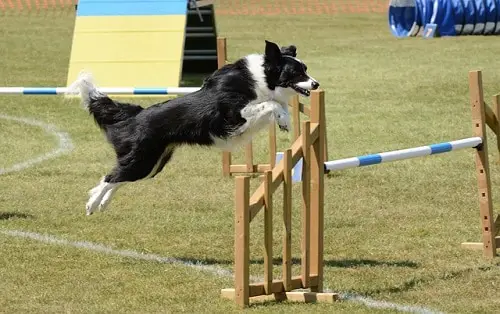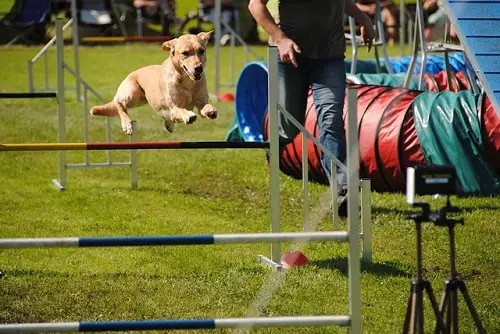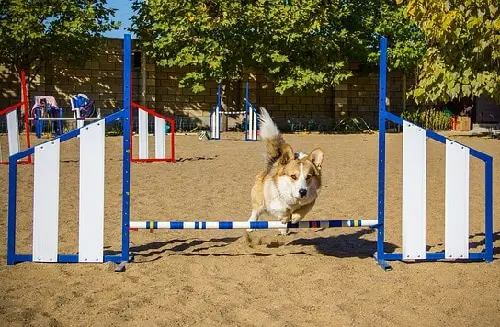Agility is a popular canine sport in which you have to guide your dog through an obstacle course. But as with any other activity, you will need the right equipment to get started. Whether you want to compete or have fun in your backyard, here’s what you should get for dog agility training.
You can start dog agility training with the essential equipment, including a tunnel, jumps, and weave poles. Then, you might also need more advanced obstacles such as a dog walk, A-frame, and seesaw. Apart from that, you can also benefit from gear and accessories to help you train your dog on the agility course.

Dog Agility Equipment List
Obstacles:
- Tunnel.
- Jumps.
- Weave Poles.
- Pause Table.
- Dog Walk.
- A-Frame.
- Seesaw.
Training Aids:
- Treats or Toys.
- Bait Bag.
- Clicker or Whistle.
What Does A Dog Agility Course Consist Of?
An agility course is composed of various obstacles your dog must go through as fast and accurately as possible. So as you can imagine, some equipment is necessary to get started and enjoy this activity.
What Equipment Is Used In Agility?
In dog agility, there are two types of equipment used. The obstacles you will find on the course and the accessories you will use for training. Jumps, tunnels, and weave poles are useless if you don’t have the right gear to teach your dog how to go through them.
But at the same time, you might not need all the equipment listed above. That’s why you have to understand why each item can be necessary for agility. With that in mind, you will be able to make your own list of essentials to start training your dog on an obstacle course!
Obstacles.
When it comes to dog agility, obstacles are probably the first pieces of equipment that come into your mind. The most common ones used for agility training are tunnels, jumps, and weave poles.
But if you plan to compete, there are many other obstacles you and your dog might have to master. Depending on which agility class you will participate in, you might encounter a pause table, A-frame, teeter-totter, or dog walk.
So let’s find out more about all the obstacles you might come across during dog agility training!
Tunnels.
There are two types of tunnels in dog agility:
- Open Tunnels
- Closed Tunnels or Chutes.
An open tunnel is a long tubular obstacle with two openings at each end in which your dog has to run through as fast as possible. It’s generally an excellent obstacle to start with because it’s one of the easiest to master.
A closed tunnel or chute is a tunnel divided into two parts. It’s composed of a barrel (a short open tunnel) and an attached material chute at the other end.
But don’t worry too much about this obstacle because most agility organizations don’t use it anymore. Around 2016, they found out closed tunnels were problematic for dogs and their performance, especially on more advanced courses.
Jumps.
In general, jumps and hurdles are what mainly compose an agility course. Those are obstacles dogs have to leap over. Depending on their size and agility class, the height and type of jump will vary a lot.
List Of Agility Jumps:
- Bar Jumps:
- One Bar Jump.
- Double Bar Jump.
- Triple Bar Jump.
- Panel Jump.
- Tire Jump.
- Board Jump.
Weave Poles.
The weave poles obstacle is pretty self-explanatory. It’s a section in which your dog has to weave through a line of poles. Although it’s one of the most dreaded obstacles in agility, it’s an essential piece of equipment for training.
Learn more about dog agility weave poles!
Pause Table.
A pause table is an obstacle your dog has to jump on, stay immobilized for a few seconds, and then continue on the agility course. It’s a square table very similar to a stool. Once again, the height will depend on the dog’s size and agility class.
Dog Walk.
The dog walk is a contact obstacle with two ramps at each end and one long platform in the middle. So your dog has to climb on the upward ramp touching the contact zone, walk/run over the flat section, and make contact with the second contact zone when exiting the downward ramp.
A-Frame.
An A-frame is basically a dog walk without the flat platform in the center. It’s another essential agility equipment composed of two ramps forming an A. Your dog will have to climb over one side and go down the other one while touching both contact zones.
Seesaw. (or Teeter-Totter)
The seesaw is another contact obstacle composed of a long plank with a pivot base in the center. Your dog will have to climb on the first half of the teeter-totter, pass the middle, wait for the platform to pivot, and exit the obstacle touching both contact zones.
Here’s more information about contact obstacles!
Training Gear.
Apart from the obstacles, you will also need equipment to train your dog for agility. There are many ways to make this long and laborious process more fun and efficient. One of them is to use training aids and accessories.
Treats or Toys.
Having a source of motivation is essential when teaching something to your dog with positive reinforcement. Whether it’s some playtime with a toy, high-value treats, or a lot of praise, rewards are necessary during agility training.
Bait Bag.
If you opt for treats, a bait bag can be very convenient and save you a lot of time. It will allow you to have rewards at the reach of hand during training. Instead of opening the original treat bag every time you want to reward your dog, you will be able to pick one in your bait bag.
Clicker or Whistle.
Depending on your training method, a clicker or whistle might be helpful and even necessary in some cases. Specific noises can also be good to catch your dog’s attention and communicate on the agility course.
Your voice and tone might change from one time to another, while clicker or whistle sounds are more likely to be consistent. That’s why they can be great training aids to improve your dog’s agility skills.
Other Dog Agility Equipment.
There are probably some other gear and accessories that could be great for agility training. But you should be more than ready to start with the equipment I’ve mentioned above. And even some items on my list aren’t indispensable for dog agility.
For example, you can start with only an open tunnel, a few jumps, weave poles, and treats. Some more advanced equipment such as bait bags or wobble boards might not be necessary for you.

Dog Agility Equipment Specifications
Now you should have a better idea of what equipment you need for dog agility training. But it can be helpful to know the specifications for each of them.
When it comes to obstacles, organizations have put in place specific requirements for competitions. The course and obstacles might change according to your dog’s size and agility class.
Here are the obstacle specifications for AKC agility events. (Retrieved from chapter 3 of their rulebook)
A-Frame Specifications.
The A-Frame construction consists of two flat and straight panels made from wood or any other appropriate material for the dog to climb on. The connection between both panels must eliminate gaps large enough to fit a dog’s foot or toe.
The A-Frame surface has to be non-slip, and there must be slats across the width of the panels. The interval between slats should be around 12-inch with a 2-inch tolerance (except there is no slat within the top of a contact zone), and they must extend to within ¼-inch of the panel sides.
Panels Dimensions:
- Width: 35 to 49 inches.
- Length: Within 2 inches of 9 feet.
A-Frame Height:
- Within 1 inch of 5 feet 6 inches.
- Within 1 inch of 5 feet for the 4-inch and 8-inch jump height class.
Slats Dimensions:
- Thickness: ⅜-inch to ½-inch.
- Width: ¾-inch to 1 ½-inches.
Contact Zones:
- Lower 42 inches of both panels with a ¼-inch tolerance. (Bright yellow)
Dog Walk Specifications.
This obstacle has a center section and two ramps for a total of three planks. All surfaces of the dog walk must be non-slip and made from wood or any other material on which you can easily add a layer.
The transition parts between sections can’t have gaps in which a dog’s toe or foot could fit. Ramps of the dog walk also need slats with identical dimensions and specifications to those required for the A-Frame.
Planks Dimensions:
- Width: 12 inches with a 1-inch tolerance.
- Length: 12 feet.
Dog Walk Height:
- 48 inches within 2-inch tolerance.
Contact Zones:
- Lower 42 inches of both ramps with a ¼-inch tolerance. (Bright yellow)
Seesaw Specifications.
The principal part of this obstacle is a plank made of wood or any other material suitable for proper surfacing. It’s then supported near the center by a base used as a fulcrum. This base has to extend between 2 and 4 inches past the sides of the plank. (Ground support can be wider)
An appropriate balance of the seesaw is required too. It has to hit the ground in less than 3 seconds when a 3-pound weight is placed 12 inches from the raised end. The top surface of the seesaw must be non-slip, but slats aren’t allowed.
Plank Dimensions:
- Width: 12 inches with a 1-inch tolerance.
- Length: 12 feet.
Seesaw Height (At the top of the board at the pivot point):
- 24 inches with a 1-inch tolerance.
Contact Zones:
- 42 inches on both ends of the plank with a ¼-inch tolerance.
- Bright yellow.
Pause Table Specifications.
The top of the pause table is a square platform made from a non-slip surface. The color must be light and in contrast to the running surface and ring gating.
Platform Dimensions:
- Width: 36 inches with a 2-inches tolerance.
- Length: 36 inches with a 2-inches tolerance.
Pause Table Heights: (Within 1 inch)
- 8 inches for dogs in the 8-inch jump height class.
- 12 inches for dogs in the 12-inch jump height class.
- 16 inches for dogs in the 16-inch jump height class.
- 20 inches for dogs in the 20-inch and 24-inch jump height class.
- Preferred Class Requirement Might Slightly Differ.
Open Tunnel Specifications.
The open tunnel consists of a flexible tube of durable material that can be curved. It has two round openings and is secured in a position not to move when a dog runs into it. The material of the tunnel must be opaque, but it can’t be black for safety purposes.
The holder portion underneath the tunnel shall not be thicker than 1-½ inches. Supports can’t have rigid uprights that might fit between the ribs and possibly project into the tunnel. Double-lined tunnels aren’t allowed too.
Openings Height & Width:
- 25 inches +/- 2 inches with a 4-inch rib spacing required.
Length:
- From 10 to 20 feet.
Weave Poles Specifications.
The weave poles section must have a base with rigid uprights to support poles. It should also have a non-slip surface and be secured so the obstacle can’t move. The material of the poles can either be Schedule 40 pipe or furniture grade PVC.
They must be of a single color striped with a contrasting color or be of alternating colors. Base supports are within the 4 inches of the pole on the opposite side of the dog’s path.
Upright Height: (From ground to top of the rigid support)
- Under 4 inches.
Base Dimensions:
- Height: Under ¾-inch.
- Width: Under 3 ½-inches.
- Length: Between 6 and 18 inches.
Poles Dimensions:
- Diameter: Nominal pipe size of ¾-inch PVC (1-inch approximate outside diameter) with a tolerance of 1 1/16-inch.
- Height: 40 inches.
Weave Poles Spacing:
- Uniformly spaced at 24 inches with a ½-inch tolerance.
Stripes:
- Start at 20 inches of the ground.
- One stripe at every 10 inches.
Jump Specifications.
Since there are many types of jumps, the requirement for this obstacle will vary a lot. The height will also change according to the agility class and size of the dog. But bar jumps are generally the most common obstacles found on a standard course.
It consists of a bar held by supports and uprights. Jump wings on the uprights are allowed. The bar can’t be attached to the uprights or supports. It also has to be made from Schedule 40 PVC or Schedule 40 furniture-grade PVC and stripped for visibility.
Height: With a 1/4-inch tolerance.
- 4 inches.
- 8 inches.
- 12 inches.
- 16 inches.
- 20 inches.
- 24 inches.
Bar Dimensions:
- Diameter: Nominal pipe size of 1-inch PVC (1 5/16-inches approximate outside diameter) with a 1/16-inch tolerance.
- Length: 4 to 5 feet.
For more information about all the types of jumps and their specifications, you can read section 3 of chapter 3 in the AKC Agility Rulebook.
Agility Training Equipment Specifications
When it comes to training your dog for agility, there are no rules. So you can use whatever equipment you want for this part of the process. But once you’re ready to compete, keep in mind that food, toys, and other training aids aren’t allowed on the course.
What If You Don’t Plan To Compete In Agility?
The specifications for obstacles and agility equipment mentioned above only apply to people who plan to participate in official events. The AKC and other agility organizations have specific requirements for competitions.
If you plan to do agility at home, you can use any equipment regardless of its specifications. There might also be unofficial events where obstacles don’t comply with the standard requirements.
Best Dog Agility Equipment!
Now that you have a better of what you need, it’s time to gear up properly. With all the dog agility equipment out there, it can be overwhelming to choose the perfect options for you. So here are some of the best obstacles, training aids, and sets I’ve found.
Beginner Agility Training Starter Kit:
High-Quality Dog Agility Set:
Best Open Tunnels For Agility Training:
Best Agility Jumps For Dogs:
Best Weave Poles For Dog Agility:
Best Dog Agility A-Frame:
Best Dog Walk For Agility:
Best Agility Teeter-Totter For Dogs:
Best Pause Table:
For the best toys and treats during agility training, it will depend on the dog. Usually, tug toys like the K9 Dog Bite are great for this purpose, but any of his favorite toys can do the job.
If you use treats as rewards, a treat pouch such as this one made by Paw Lifestyle can be very convenient. Apart from that, a clicker or whistle might also help you train your dog for agility more efficiently.
Homemade Dog Agility Equipment
If you don’t want to spend a lot of money and you’re into DIY projects, you can always make your own agility course at home. There are many ways to build homemade obstacles and start training your dog in your backyard.
Other Things You Need For Dog Agility!
Although the equipment is an essential part of agility training, it’s not the only element required to enjoy this activity.
The Right Dog.
First of all, you will need an appropriate partner to get into dog agility. Otherwise, your equipment is useless. Keep in mind that not every dog is well-suited for such an intense sport.
You don’t have to choose among the best dog breeds for agility. Just make sure your companion is healthy enough and suitable to run through an obstacle course.
Knowledge & Handling Skills.
Once you have the right partner, you must learn about dog agility and training. Teaching your dog new skills and using the equipment effectively isn’t that easy. Fortunately, there are many resources such as my blog posts or books to help you all along the process.
Patience & Determination.
Finally, training your dog for agility is long and demanding. Thus, you will need a lot of patience and determination to succeed. But believe me that all the efforts you put into this activity are worth all the fun you will have on the obstacle course.
So, What Equipment Do You Need For Dog Agility Training?
Essential obstacles, including a tunnel, weave poles, and jumps, are all the pieces of equipment required to start dog agility at home. Then, you might need training aids to motivate your partner and help him improve his skills more efficiently.

If you plan to participate in an official competition, more obstacles and accessories might be necessary too. Either way, the more equipment you have for agility training, generally the better and safer it is. Now it’s time to invest in the right gear and go practice with your dog.
Have Fun Training Your Dog For Agility!